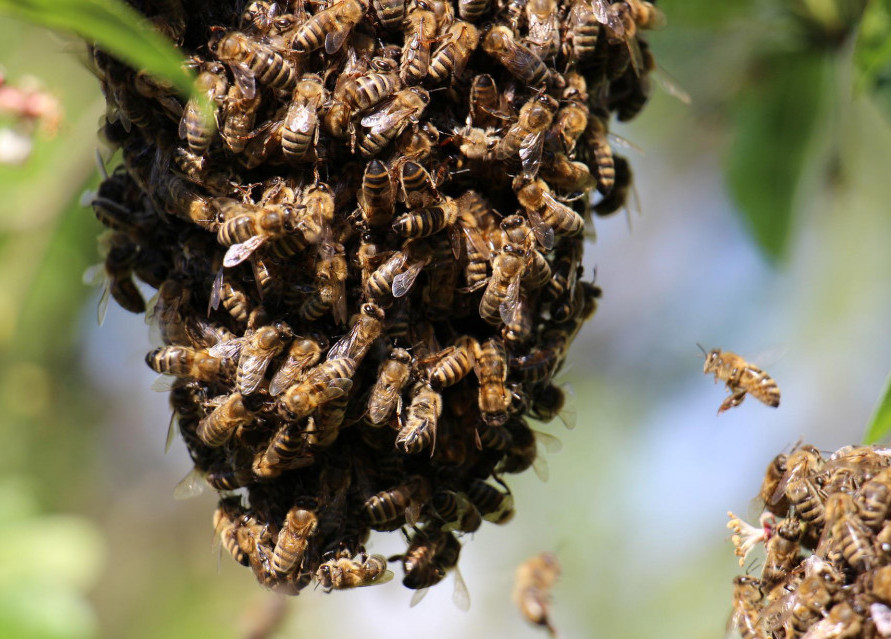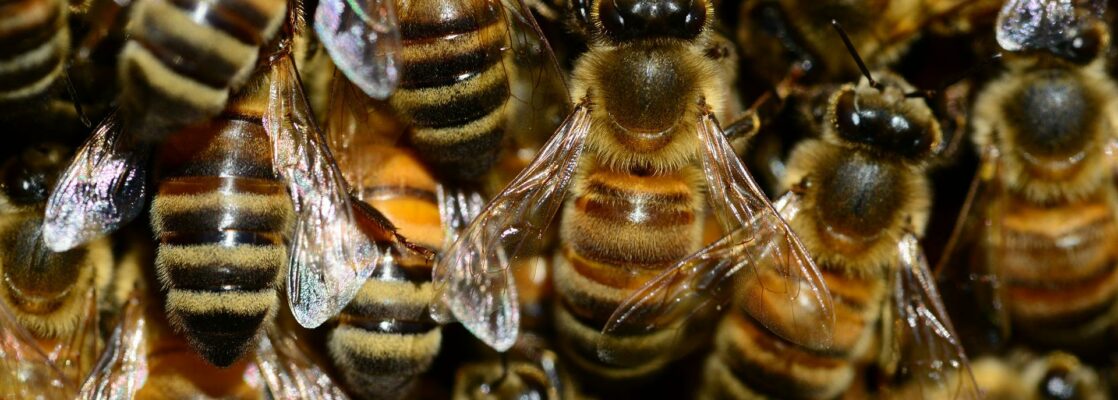 Honey bee swarming is a regular part of life for honey bees. Swarming is when the queen bee takes off with half of the hives’ population to go live somewhere else.
Honey bee swarming is a regular part of life for honey bees. Swarming is when the queen bee takes off with half of the hives’ population to go live somewhere else.
The bees that swarmed leave behind the other half of the hive to create a new queen.
Regardless if you are new to beekeeping or if you haven’t kept bees before in your life, all of us at some point have seen a swarm of bees hanging out on a tree branch, mail box, or in many other odd locations.
If you are new to beekeeping, a hive swarming could mean honey loss or depending on the time of year it could also be threatening to your hive.
Why would a hive swarm?
Typically after a hive has made it through an entire year, the hive will swarm. The hive could have been overly crowded and they need room to grow. This is their way of “reproducing.” I know what you’re thinking: doesn’t the queen bee already “reproduce” by laying eggs daily? Yes, however, this is a way for the hive to create an entirely new hive with a new queen. Basically, the hive is too big and so they split it.
Basically, the hive is too big and so they split it.
Other reasons why a hive would take off completely could be due to parasites or their living conditions are not tolerable for the survival of the hive.
As mentioned in a previous article about replacing a queen, the worker bee determines whether a fertilized egg is a queen or not. The worker bees feed the fertilized egg royal jelly and nothing else for the egg to become a queen.
The process of creating a new queen is not determined by one egg alone but rather by several eggs. Whichever egg emerges first is the queen bee. She will then use her stinger to kill all the remaining queen cells since there can only be one queen.
When do honeybees swarm?
When I was new to beekeeping, I was under the impression that the hive only swarms in the spring. I also thought it only occurred with well-established hives and they waited until the new “daughter queen” had emerged. If I were to purchase a package of bees, I thought this hive would not swarm until an entire year had passed. None of that is true. I was so naive!
Usually you will see a cluster of bees who have swarmed in the spring. A lot of the calls received to beekeepers to go collect swarms is typically around early to mid spring. In a perfect honey bee world this is how it works. However, that is not always the case. Sometimes, they will swarm mid-summer or I even had one swarm on me in the fall! Honey bees can swarm at any point during the bee season.
What should I do if my hive swarms?
If your hive swarms and you’re able to catch it early enough, you can check to see if they are clustered in a nearby tree or if they ventured off somewhere close. Other than that, you work towards making sure the remaining bees are taken care of.
they ventured off somewhere close. Other than that, you work towards making sure the remaining bees are taken care of.
You have a couple of options. If your bees swarmed early in the season, you could wait until the new queen emerges and allow the natural process to take place.
Just keep in mind that it may slow down the honey flow and you may have to monitor that hive a little more carefully to ensure they have the food they need going into winter due to the delay while waiting for the queen to take hold.
The other option is if it’s too late in the season and you know the hive does not have enough time to make a new queen, you could also replace her. This can be a bit tricky.
If the hive has already begun the process of creating a new queen, you take the risk of your newly-installed-already-mated queen being killed by the hive. In which case, you have wasted money on a queen.
The trick is to notice your hive has swarmed and act quickly if it’s late in the season and you know you need to replace a queen. By replacing her, you have eliminated the time it takes for the egg to be come a queen, for her to then mate with multiple drones and come back ready to spend the rest of her life laying eggs all before winter hits.
How can I prevent my hives from swarming?
I remember one year I saw a few frames had the start of a few queen cells. This was around early June and my thought process was to remove the queen cells to stop them from swarming. Again, I was new to beekeeping and so very naive! This did not stop them. Once the pheromones are in the hive to swarm, you cannot stop the hive.
However, most beekeepers in the spring will split the hive to create not only a new hive but also give the hive more room to grow to prevent the need to swarm.
Another option is to make sure your hive is healthy with a low mite population to make sure the hive is not leaving due to a pest problem or an unhealthy living environment.
A few words to wrap up.
Beekeeping is a learning experience. I have been told many times that you cannot train bees but instead the honey bees will train you. As you learn, you also figure out how they communicate what’s going on inside the hive.
Regardless, swarming is a part of what honeybees do. If you are not a beekeeper and find a swarm of bees, the best thing to do is to either leave them alone or reach out to a local beekeeper or a local club who knows how to safely remove the hive. If you are a beekeeper, it is best to learn and educate yourself before going out to collect a swarm.
Please feel free to leave any questions, comments or swarm stories of your own!


2 comments on “Honey bee swarming – What should you do if your hive swarms?”
moses456
June 9, 2022 at 8:27 amI never kept honey bees, I always watched on youtube or saw it on TV, but I never paid attention to details of how they keep, and the process, I never imagined it is this much complicated and the queen plays very important role inside the hive, and didn’t know there are tricks to keep the hive from swarming.
This was really informative post, first time I am understanding how the process goes.
LineCowley
June 9, 2022 at 8:44 amThis is a very helpful post on swarming of bees. A friend has been keeping bees and was very distraught when the hive took off, and we were wondering why this could happen. So it is very interesting the read that it is a way of bees “dividing” the hive and starting with a new queen.
Finding that the process of creating a new queen is not determined by one egg alone but rather by several eggs, is fascinating. With the queen bee emerging as the first, and she then kills the other, really shows survival of the fittest in nature.
I will be sharing this post with my bee keeping friends to help them with swarming hives and trying to prevent it.